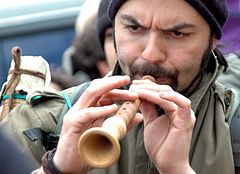Ciaramella
| Ciaramella | |
|---|---|
| also cennamella , ciaramedda , cornetta , totarella , trombetta , bìfara , pipìta | |
| classification | Woodwind instrument , double reed instrument , shawm instrument |
| range | approx. a ninth |
The ciaramella is a traditional shawm that is common in central southern Italy ( Lazio , Molise , Campania , Lucania and Calabria ). Its sound is produced by a double reed . It is related to the Piffaro in the northern Apennines .
etymology
The name Ciaramella goes back to the old French chalemel "reed instrument, shawm". This comes from the Latin calamellus "small tube, writing tube", which comes from the ancient Greek κάλαμος "tube". Cennamella is also used synonymously in Italian . Regional names are ciaramedda , cornetta , totarella , trombetta , bìfara or pipìta .
The plural forms le ciaramelle (northeastern Latium: Alta Sabina) and i ciarameddi (Calabria, Sicily) denote the bagpipe (otherwise Zampogna ). The two chanter of the Zampogna correspond in structure to the shawms.
The ciaramella is to be distinguished from the Corsican cialamella ( cialamedda ), which belongs to the single-reed instruments .
Construction
The Ciaramella has a relatively long, trapezoidal reed that is inserted onto a metal connecting tube without pirouette . It has a conical inner bore and a conical horn. The instrument is usually made of two pieces - the tube ( canna ) and the bell ( campagna ) - which are connected by a wooden screw thread. They are rarely put together.
The Ciaramella has seven (Campania, Basilicata, Apulia, Calabria) or eight (Lazio, Abruzzo, Molise) handle holes on the front and one thumb hole. There are also several sound or vocal holes. The range of the diatonic scale ranges from an octave to a decime . The Ciaramella is only built without flaps.
Most of the time, the ciaramella is made by the same instrument makers as the bagpipe. The length of the instrument depends on the key of the bagpipe that is being accompanied, so it is the same length or half as long as the longest melody tube of the zampogna.
use
A ciaramella is seldom played alone. It is often accompanied by the Zampgna zocca or the Zamgpogna a chiave . The ciaramella takes over the leading melody that accompanies Zampogna. Two shawms usually sound in a third interval.
During the Christmas season in the 19th century, shepherds from rural regions came with these instruments as wandering musicians in the cities, namely to Rome, to make music there. But bagpipes were and are played with shawms on other cultural and social occasions as well. The traditional repertoire of these groups consists of dances ( saltarello , Ballarella , Tarantella ) and pastorals . Today there are also modern popular pieces.
In some areas of Lucania a player plays two ciaramelle at the same time ( Coppia di ciaramelle ) - as in the ancient aulos . The “female” shawm ( great ) plays the upper part, the “male” ( seconda ) the lower part. Different holes are drilled or some finger holes are closed with wax.
Individual evidence
- ↑ a b c d e Cupa Cupa. Archived from the original on May 12, 2006 ; accessed on September 7, 2016 .
- ^ Etymology of the Italian word ciaramella. Retrieved January 30, 2010 (English).
- ↑ a b c d e f g h Suoni Della Terra .com. Archived from the original on December 29, 2009 ; accessed on September 7, 2016 .
- ^ Strumenti. Retrieved September 4, 2016 .
- ↑ La Ciaramella / La Terra di Nessuno. (No longer available online.) Archived from the original on February 13, 2012 ; accessed on January 31, 2010 . Info: The archive link was inserted automatically and has not yet been checked. Please check the original and archive link according to the instructions and then remove this notice.
Web links
- Ciaramelle e Fiati. Retrieved September 7, 2016 .
- Video: Two Zampogne a chave, Ciramella and Coppia di ciaramelle. Retrieved January 31, 2010 .

